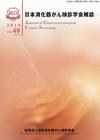Volume 49, Issue 6
Displaying 1-9 of 9 articles from this issue
- |<
- <
- 1
- >
- >|
Original article
-
2011 Volume 49 Issue 6 Pages 1087-1095
Published: 2011
Released on J-STAGE: December 15, 2011
Download PDF (2350K) -
2011 Volume 49 Issue 6 Pages 1096-1104
Published: 2011
Released on J-STAGE: December 15, 2011
Download PDF (1272K) -
2011 Volume 49 Issue 6 Pages 1105-1113
Published: 2011
Released on J-STAGE: December 15, 2011
Download PDF (1675K) -
2011 Volume 49 Issue 6 Pages 1114-1120
Published: 2011
Released on J-STAGE: December 15, 2011
Download PDF (1674K)
Case study
-
2011 Volume 49 Issue 6 Pages 1121-1126
Published: 2011
Released on J-STAGE: December 15, 2011
Download PDF (6635K) -
2011 Volume 49 Issue 6 Pages 1127-1136
Published: 2011
Released on J-STAGE: December 15, 2011
Download PDF (6861K)
Abstracts of local chapters
-
2011 Volume 49 Issue 6 Pages S1137-S1152
Published: 2011
Released on J-STAGE: January 27, 2016
Download PDF (1035K) -
2011 Volume 49 Issue 6 Pages S1153-S1168
Published: 2011
Released on J-STAGE: January 27, 2016
Download PDF (1019K) -
2011 Volume 49 Issue 6 Pages S1169-S1179
Published: 2011
Released on J-STAGE: January 27, 2016
Download PDF (940K)
- |<
- <
- 1
- >
- >|
